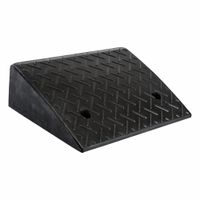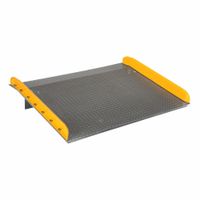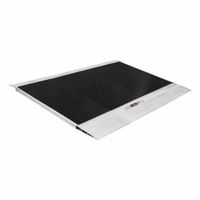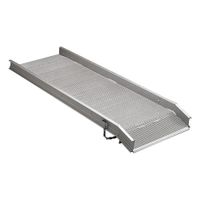Call +(254) 703 030 000 / 751 483 999 / 721 704 777
- Home
- Material Handling
- Dock Loading Equipment
- Loading Ramps Plates Boards
.....Read More
Frequently Asked Questions
What are the different types of loading ramps and their uses?
There are several types of loading ramps, each designed for specific applications and environments:
1. **Yard Ramps**: These portable ramps are used to load and unload trucks and trailers when a permanent dock is unavailable. They are often equipped with wheels for mobility and can handle heavy loads, making them ideal for warehouses and distribution centers.
2. **Dock Boards**: These are portable, bridge-like structures used to span the gap between a loading dock and a truck or trailer. They are typically made of aluminum or steel and are suitable for lighter loads. Dock boards often have curbs to prevent forklifts from driving off the edge.
3. **Dock Plates**: Similar to dock boards but lighter and without curbs, dock plates are used for hand trucks and pallet jacks. They are ideal for lighter loads and are easy to move and position.
4. **Vehicle Ramps**: These ramps are used to load vehicles onto trailers or trucks. They come in various sizes and materials, such as aluminum or steel, and are designed to support the weight of vehicles like cars, motorcycles, or ATVs.
5. **Walk Ramps**: Designed for manual loading and unloading, walk ramps are lightweight and portable. They are used by delivery personnel to move goods from trucks to ground level without the need for a forklift.
6. **Container Ramps**: These ramps facilitate the loading and unloading of shipping containers. They are robust and can handle heavy equipment like forklifts, making them essential for ports and shipping yards.
7. **Wheelchair Ramps**: These ramps provide accessibility for individuals using wheelchairs or mobility devices. They are used in public buildings, homes, and vehicles to ensure compliance with accessibility standards.
Each type of ramp is designed to meet specific needs, ensuring safe and efficient loading and unloading operations across various industries.
How do I choose the right loading ramp for my needs?
To choose the right loading ramp, consider the following factors:
1. **Load Capacity**: Determine the maximum weight the ramp needs to support, including the weight of the equipment and any additional load. Choose a ramp with a capacity that exceeds this total weight to ensure safety.
2. **Ramp Material**: Select a material based on durability, weight, and environmental conditions. Aluminum ramps are lightweight and resistant to rust, while steel ramps offer higher strength and durability. Rubber ramps provide good traction and are suitable for lighter loads.
3. **Ramp Length and Slope**: Calculate the appropriate ramp length to achieve a safe slope. A gentler slope is safer and easier to navigate. Use the formula: Ramp Length = (Height of Loading Surface / Desired Slope Ratio). A common safe slope ratio is 1:12 (1 inch of rise per 12 inches of ramp).
4. **Width**: Ensure the ramp is wide enough to accommodate the equipment being loaded, with extra space for maneuverability. Consider the width of the widest equipment and add a safety margin.
5. **Surface Texture**: Choose a ramp with a non-slip surface to prevent accidents, especially in wet or icy conditions. Look for features like serrated crossbars or textured surfaces.
6. **Portability and Storage**: If the ramp needs to be moved frequently, consider its weight and whether it has handles or wheels for easy transport. Folding ramps offer compact storage options.
7. **Compatibility**: Ensure the ramp is compatible with the loading surface, whether it's a truck bed, dock, or trailer. Check for features like adjustable height or lip extensions.
8. **Safety Features**: Look for additional safety features such as side rails, safety chains, or locking mechanisms to secure the ramp during use.
9. **Budget**: Balance your needs with your budget, considering both initial cost and long-term durability.
By evaluating these factors, you can select a loading ramp that meets your specific requirements safely and efficiently.
What materials are loading ramps typically made from?
Loading ramps are typically made from a variety of materials, each chosen for specific properties that suit different applications. Common materials include:
1. **Aluminum**: Lightweight and resistant to corrosion, aluminum is often used for portable ramps. Its strength-to-weight ratio makes it ideal for applications where the ramp needs to be moved frequently, such as in personal vehicle loading or temporary construction sites.
2. **Steel**: Known for its durability and high load-bearing capacity, steel is used in ramps that require robustness and longevity. Steel ramps are often found in industrial settings where heavy machinery or vehicles are loaded and unloaded. They are usually coated or treated to prevent rust and corrosion.
3. **Wood**: While less common in industrial settings, wood can be used for temporary or DIY ramps. It is cost-effective and easy to work with, but it requires maintenance to prevent rot and may not be suitable for heavy loads or long-term use.
4. **Composite Materials**: These are engineered materials made from a combination of substances, such as fiberglass or reinforced plastics. They offer a balance of strength, weight, and resistance to environmental factors. Composite ramps are often used in specialized applications where specific properties are required.
5. **Rubber**: Used primarily for smaller ramps or threshold ramps, rubber provides excellent grip and is resistant to weather conditions. It is often used in residential or commercial settings for accessibility purposes.
Each material offers distinct advantages and is selected based on factors such as the weight of the load, environmental conditions, frequency of use, and budget constraints.
How do I properly maintain and store loading ramps?
To properly maintain and store loading ramps, follow these steps:
1. **Regular Inspection**: Frequently inspect ramps for signs of wear, damage, or corrosion. Check for cracks, bends, or any structural deformities. Ensure all bolts and fasteners are secure.
2. **Cleaning**: Keep ramps clean from dirt, debris, and corrosive substances. Use a mild detergent and water for cleaning, and ensure they are thoroughly dried to prevent rust.
3. **Lubrication**: Apply lubricant to moving parts, such as hinges or joints, to ensure smooth operation and prevent rust.
4. **Surface Maintenance**: For ramps with non-slip surfaces, ensure the texture remains intact. Replace or repair any worn-out non-slip coatings to maintain safety.
5. **Weight Capacity**: Always adhere to the manufacturer's specified weight limits to prevent structural damage. Overloading can lead to premature wear or failure.
6. **Storage**: Store ramps in a dry, covered area to protect them from weather elements. If possible, keep them off the ground to prevent moisture accumulation.
7. **Proper Handling**: Use appropriate lifting techniques or equipment to move ramps, avoiding dropping or dragging them, which can cause damage.
8. **Environmental Considerations**: If ramps are used in corrosive environments, consider additional protective coatings or materials designed to withstand such conditions.
9. **Training**: Ensure all personnel handling ramps are trained in proper usage and maintenance procedures to prevent misuse and damage.
10. **Documentation**: Keep a maintenance log to track inspections, repairs, and any issues encountered. This helps in identifying patterns and scheduling regular maintenance.
By following these guidelines, you can extend the lifespan of loading ramps and ensure they remain safe and functional for use.
What are the weight capacity limits for different loading ramps?
Loading ramps come in various types and materials, each with specific weight capacity limits. These limits are crucial for ensuring safety and efficiency during loading and unloading operations. Here are the general weight capacity limits for different types of loading ramps:
1. **Aluminum Ramps**: Typically used for lighter loads, aluminum ramps are portable and corrosion-resistant. They generally have weight capacities ranging from 600 to 3,000 pounds, making them suitable for motorcycles, ATVs, and small equipment.
2. **Steel Ramps**: Known for their durability and strength, steel ramps can handle heavier loads. They often have weight capacities between 3,000 and 10,000 pounds, ideal for vehicles like cars, trucks, and heavy machinery.
3. **Folding Ramps**: These ramps are designed for convenience and portability, often made from aluminum or steel. Their weight capacity can vary widely, from 500 to 3,000 pounds, depending on the material and design.
4. **Commercial Loading Docks**: Used in industrial settings, these ramps are built to accommodate large trucks and heavy equipment. They can support weights from 10,000 to over 30,000 pounds, depending on the construction and materials used.
5. **Yard Ramps**: Designed for loading and unloading directly from ground level to a truck or dock, yard ramps are robust and can support weights from 16,000 to 30,000 pounds or more, depending on the model.
6. **Vehicle-Specific Ramps**: These are tailored for specific vehicles like wheelchairs or mobility scooters, with weight capacities ranging from 600 to 1,500 pounds.
Always check the manufacturer's specifications for exact weight limits and ensure the ramp is suitable for the intended load to prevent accidents and equipment damage.
How do I safely use a loading ramp to prevent accidents?
To safely use a loading ramp and prevent accidents, follow these guidelines:
1. **Inspection**: Before use, inspect the ramp for any damage, such as cracks, bends, or loose parts. Ensure all safety features, like side rails and non-slip surfaces, are intact.
2. **Weight Capacity**: Verify the ramp's weight capacity and ensure it can support the combined weight of the load and equipment. Never exceed this limit.
3. **Surface Conditions**: Ensure the ramp surface is clean and dry to prevent slipping. Remove any debris, oil, or water.
4. **Secure Placement**: Position the ramp on a stable, level surface. Use safety chains or straps to secure it to the vehicle or loading dock to prevent movement.
5. **Angle and Alignment**: Set the ramp at the correct angle, ensuring it is not too steep. Align it properly with the vehicle or dock to avoid misalignment during loading.
6. **Use Proper Equipment**: Utilize appropriate equipment, such as forklifts or dollies, designed for ramp use. Ensure operators are trained and aware of ramp safety procedures.
7. **Load Distribution**: Distribute the load evenly across the ramp to maintain balance and prevent tipping.
8. **Speed and Control**: Move slowly and steadily up and down the ramp. Avoid sudden movements or changes in direction.
9. **Visibility and Communication**: Ensure clear visibility for operators and use hand signals or communication devices to coordinate movements.
10. **Personal Protective Equipment (PPE)**: Wear appropriate PPE, such as gloves, helmets, and non-slip footwear, to enhance safety.
11. **Emergency Preparedness**: Have a plan in place for emergencies, including first aid kits and emergency contact numbers.
By adhering to these practices, you can minimize the risk of accidents and ensure a safe loading and unloading process.
What are the differences between dock plates, dock boards, and dock levelers?
Dock plates, dock boards, and dock levelers are all equipment used to bridge the gap between a loading dock and a truck or trailer, but they differ in design, capacity, and functionality.
Dock Plates:
- Dock plates are flat, portable devices typically made of aluminum or steel.
- They are lightweight and designed for manual handling, making them easy to move and position.
- Dock plates are suitable for light-duty applications, such as hand trucks or manual pallet jacks.
- They have a lower weight capacity compared to dock boards and dock levelers, usually supporting up to 5,000 pounds.
- Dock plates have a simple design with no curbs, making them ideal for small height differences.
Dock Boards:
- Dock boards are more robust and heavier than dock plates, often made of steel.
- They are equipped with curbs on the sides to prevent equipment from rolling off.
- Dock boards are designed for heavier loads, such as forklifts, with weight capacities ranging from 10,000 to 20,000 pounds or more.
- They often have locking legs or pins to secure them in place during use.
- Dock boards are suitable for moderate height differences and more demanding applications.
Dock Levelers:
- Dock levelers are permanent fixtures installed at the dock edge.
- They are designed to handle a wide range of vehicle heights and load capacities.
- Dock levelers can be hydraulic, mechanical, or air-powered, allowing for easy adjustment to the height of the truck or trailer.
- They provide a smooth transition between the dock and the vehicle, enhancing safety and efficiency.
- Dock levelers are ideal for high-volume operations and can support heavy equipment like forklifts.
In summary, dock plates are for light-duty, portable use; dock boards are for heavier loads with added safety features; and dock levelers are permanent, versatile solutions for high-capacity operations.





